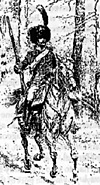 Essentially, a vedette was a mounted sentinel posted ahead of the picket (or petit poste in French service) and the duties of cavalry vedettes was to spot any movement of the enemy that could be a threat to the detachment they were protecting. We find two types of vedettes, the stationary vedette and the moving vedette (or vedette volante) whose duties are explained elsewhere in this issue.
Essentially, a vedette was a mounted sentinel posted ahead of the picket (or petit poste in French service) and the duties of cavalry vedettes was to spot any movement of the enemy that could be a threat to the detachment they were protecting. We find two types of vedettes, the stationary vedette and the moving vedette (or vedette volante) whose duties are explained elsewhere in this issue.
The Stationary Vedette
In French service, light cavalry and dragoons were assigned to vanguard duties, which consisted of a grand'garde dispatching several petits postes, which in turn placed vedettes in chosen locations. Usually a single (sometime two) vedette was posted at a critical spot and was relieved every few hours.
In case of bad weather the vedette could wear his coat but could not bring up the collar as it may have impaired his ability to hear the enemy. The vedette was not allowed to dismount under any circumstances and, as shown on the adjacent drawing, always had to keep his musket or pistol in a "high" firing position, which means that the musket had to be held by the butt in the right hand, the bottom of which was resting on the right thigh. The vedette had strict orders to fire if under attack. In that case, he was to turn his horse presenting its right flank to the enemy and only then fire to protect himself. The firing alerted the rest of the picket or petit poste toward which our vedette retreated while firing at the enemy with his carbine and pistols.
The Moving Vedette
In the adjacent illustration, the musket is held in the "high" firing position.
Sources
De Brack, Avant-postes de la cavalerie légère
A Long Range Reconnaissance.
Back to On the Mission of Light Cavalry.
Back to Empire, Eagles, & Lions Table of Contents Vol. 3 No. 1
© Copyright 1996 by Jean Lochet
This article appears in MagWeb (Magazine Web) on the Internet World Wide Web.
Other military history articles and gaming articles are available at http://www.magweb.com
